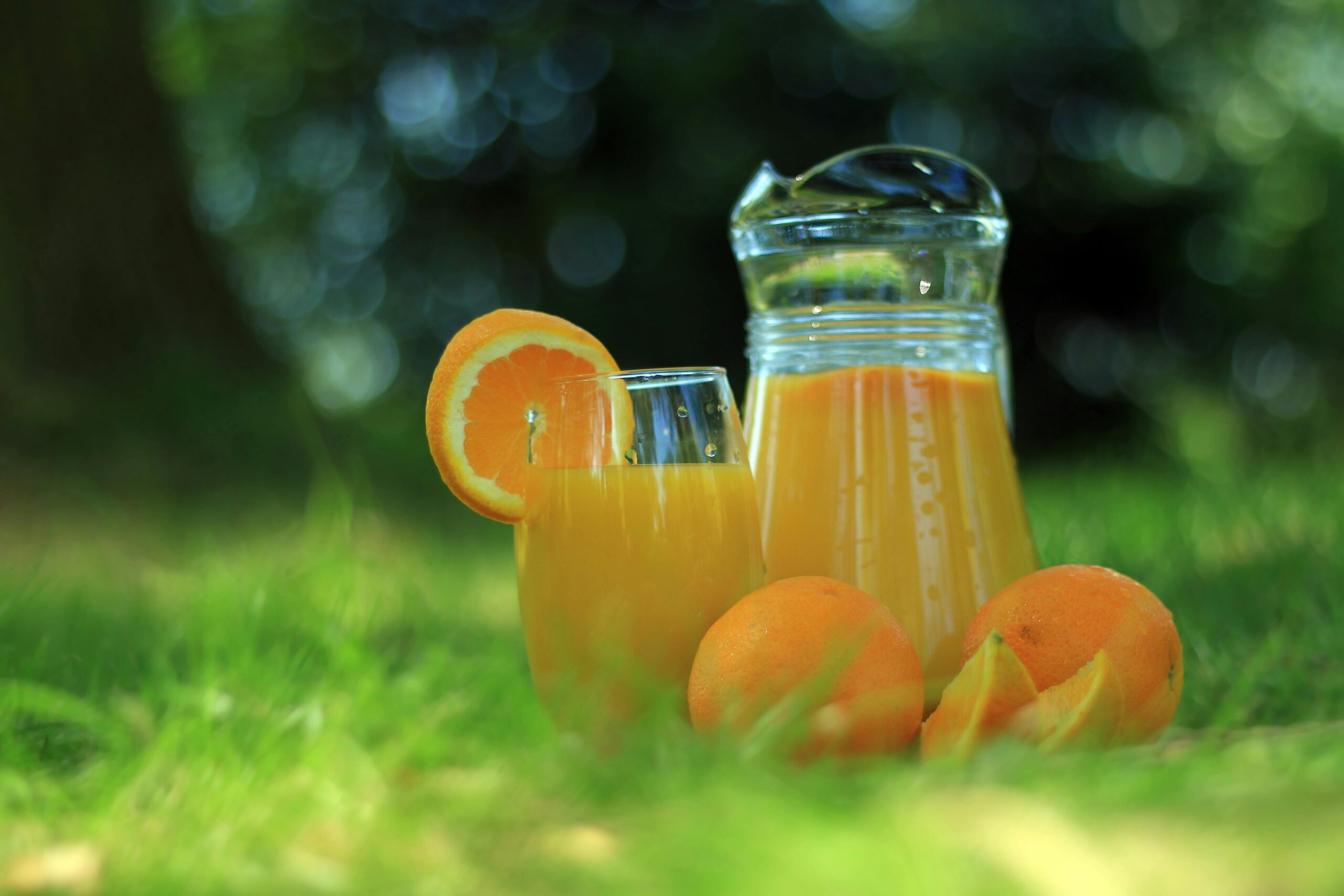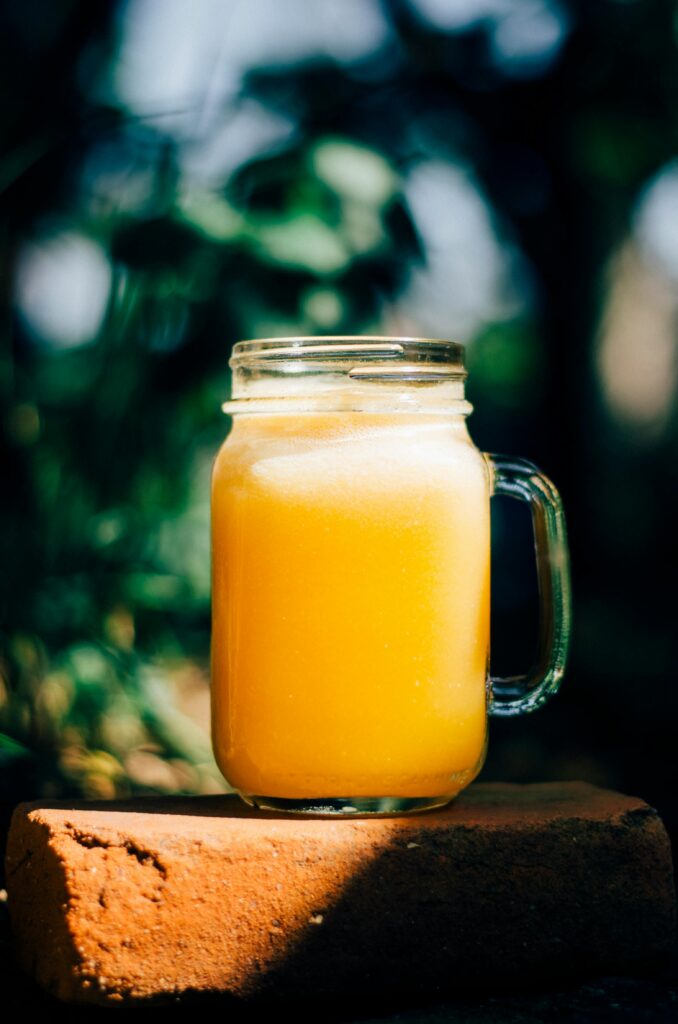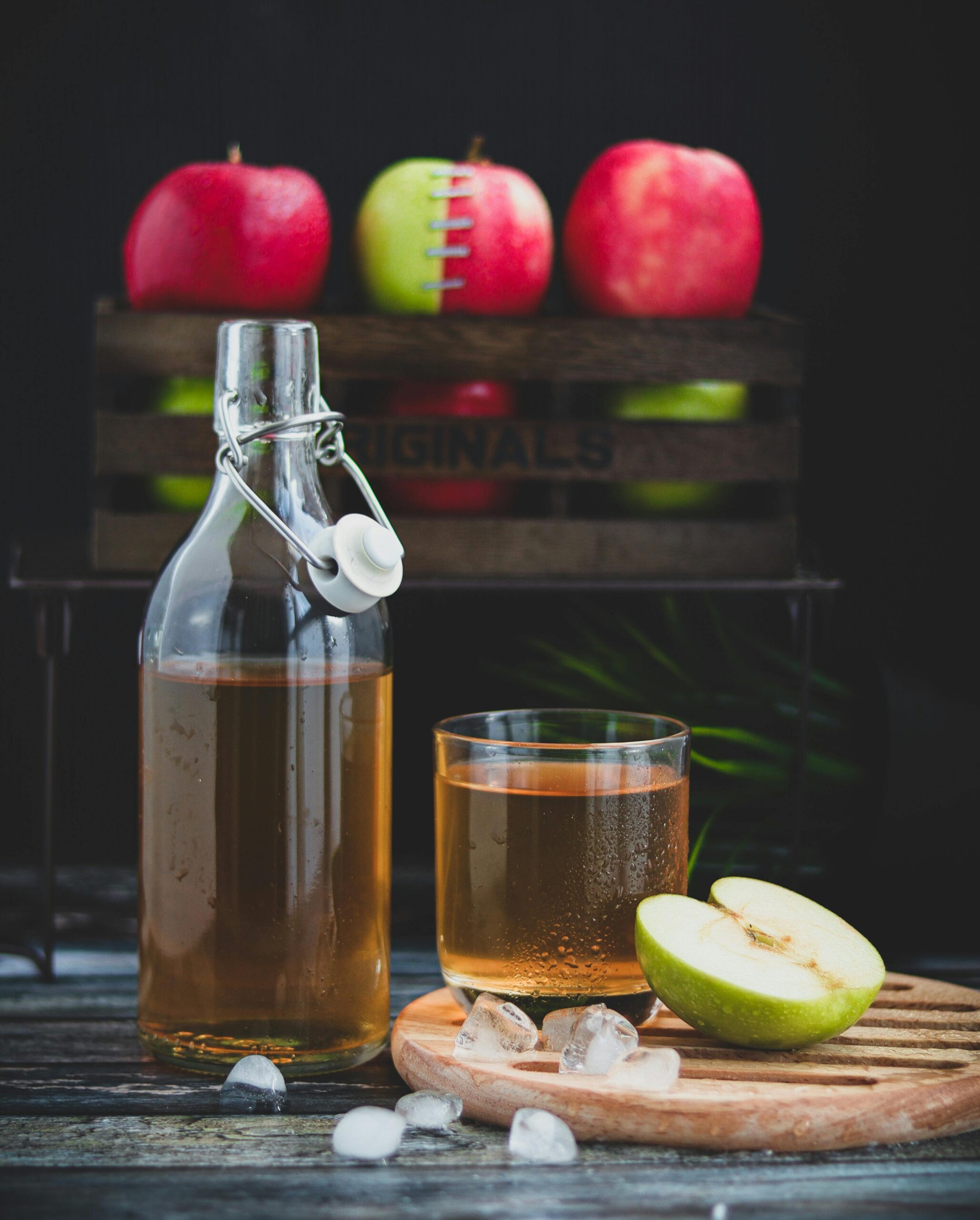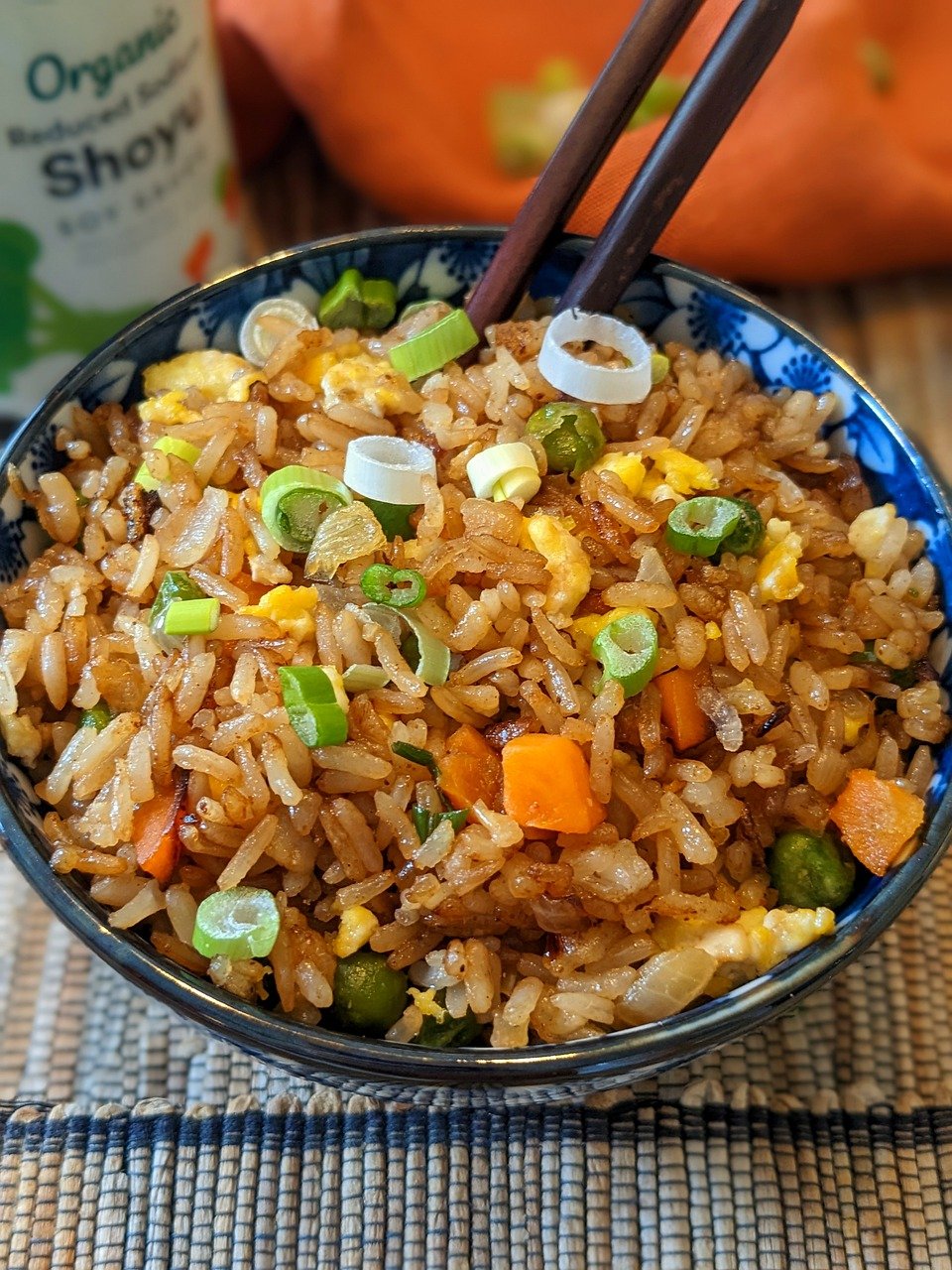Orange Juice is one of the most popular beverages worldwide, enjoyed for its refreshing taste and numerous health benefits. This bright, tangy drink is made primarily from oranges, either freshly squeezed or processed commercially, and is celebrated for being a rich source of essential nutrients, particularly vitamin C.

In this exploration, we’ll delve deep into the production, nutritional value, health benefits, varieties, and even some concerns related to orange juice.
Production Of Orange Juice
1. Freshly Squeezed Orange Juice
The simplest and purest form of orange juice is made by squeezing fresh oranges, a process that retains all the natural nutrients, fibers, and flavors. The juice can be made at home using manual or electric citrus juicers.
Freshly squeezed orange juice is usually pasteurized, meaning it hasn’t been heat-treated to kill bacteria, so it’s best consumed immediately or within a short period to preserve its freshness and nutritional value.
2. Commercial Orange Juice Production
Commercial orange juice production is a more complex process. The juice is often extracted from the fruit using large-scale machinery and then pasteurized to extend its shelf life.
Pasteurization involves heating the juice to kill harmful microorganisms, but this can also slightly reduce the vitamin content, particularly vitamin C.
Benefits Of Orange Juice
- Rich in Vitamin C: Orange Juice is a potent source of vitamin C, which is essential for immune function, skin health, and the absorption of iron from plant-based foods.
- Antioxidants: Fresh orange juice contains flavonoids and carotenoids, which are powerful antioxidants that help combat oxidative stress and may reduce the risk of chronic diseases.
- Support Heart Health: Potassium in orange juice contributes to heart health by helping to manage blood pressure levels Potassium also aids in nerve function and muscle contractions.
- Hydration: Orange juice is primarily water, making it a great way to stay hydrated while also providing essential nutrients.
- Promotes Healthy Skin: The high vitamin C content in orange juice helps with the production of collagen, a protein that is vital for healthy skin and wound healing.
- May Reduce Inflammation: Some studies suggest that the antioxidants and anti-inflammatory compounds in orange juice can help reduce inflammation in the body.
Potential Drawbacks
While orange juice has numerous health benefits, it’s important to consume it in moderation due to a few potential drawbacks:
- High Sugar Content: Even though the sugars in orange juice are naturally occurring, they can still contribute to spikes in blood sugar levels. For individuals with diabetes or those watching their sugar intake, it’s best to limit orange juice consumption or choose juices with no added sugar. Dieting orange juice with water is another way to reduce its sugar content.
- Acidic Nature: Orange Juice is acidic, which can sometimes lead to heartburn or acid reflux, particularly for individuals prone to these conditions. The acid can also erode tooth enamel over time, so it’s a good idea to rinse the mouth with water after drinking orange juice or to drink it through a straw to minimize contact with teeth.
- Calorie density: Although orange juice is nutrient-dense, it’s also calorie-dense compared to whole fruits. A glass of orange juice contains more calories than a single orange, as it takes several oranges to make one serving of juice. If you’re trying to manage your weight, it may be better to eat whole oranges, which contain more fiber and are more filling.
Main Ingredients
- Fresh Oranges- Use ripe and juicy oranges for the best flavor.
- (optional) Sugar- If you prefer a sweeter juice, you can add a small amount of sugar.
- Water (optional)- To dilute the juice if you want a lighter flavor.
- Ice (optional)- For serving the juice chilled
How To Make Orange Juice
Cut oranges in half. Squeeze the juice from each half using a citrus juicer (manual or electric). After that strain the juice to remove pulp and seeds, if desired. Now serve immediately or chill in the fridge. That’s it! you can add a little water or sugar to taste if you like.
Also, Try This Recipes
Varieties of Orange Juice
- Freshly Squeezed: Made from fresh oranges, this juice has the purest, most natural flavor and is typically unpasteurized.
- Pulp Vs. No Pulp: Some people prefer orange juice with pulp, which adds texture and may retain more of the fiber found in whole oranges. Others prefer pulp-free juice for a smoother drink.
- Organic Orange Juice: Made from organically grown oranges, this type of juice is free from synthetic pesticides and fertilizers.
You’ll Need
- 6-8 medium-sized oranges (preferably Valencia or Navel)
- 1-2 tablespoons of sugar or honey (optional)
- A pinch of salt (optional)
- Ice cubes (optional)
- Mint leaves for garnish (optional)
Tools Required:
- Citrus juicer (manual or electric)
- Knife
- Cutting board
- Strainer or sieve (if you want pulp-free juice)
- Pitcher or large glass
- Spoon for stirring
- Serving glasses

Instructions
Step 1: Selecting The Oranges: Choose fresh, juicy oranges for the best results. Valencia oranges are typically the best for juicing due to their high juice content and sweet flavor.
Navel oranges are also a good choice as they are easy to peel and sweet. Make sure the oranges are firm, brightly colored, and feel heavy for their size, indicating a high juice content.
Step 2: Preparing The Oranges: Wash the oranges thoroughly under cold water to remove any dirt or residue. If the oranges have been waxed (common in commercially sold oranges), you may want to scrub them gently with a brush.
After washing, dry the oranges with a clean towel. If you prefer cold juice, you can refrigerate the oranges for a few hours before juicing. Cold oranges will yield colder juice, reducing the need for ice.
Step 3: Cutting The Oranges: Place the oranges on a cutting board and, using a sharp knife, cut each orange in half horizontally. Cutting this way exposes the maximum surface area for juicing and makes it easier to extract the juice. If you notice any seeds, you can remove them at this stage to prevent them from interfering with the juicing process.
Step 4: Juicing The Oranges: There are two main ways to extract juice from the oranges: manually or with an electric juicer.
Manual Juicing
- Hold one-half of the orange over a citrus juicer.
- Press down firmly while twisting the orange back and forth.
- The juice will collect in the juicer’s basin, while the pulp and seeds remain on top.
Electric Juicing:
- Place one-half of the orange onto the juicer’s reamer.
- Please turn on the juicer and let it overact the juice
- The juice will be collected in a container below the juicer.
Repeat this process with all the orange halves until you’ve extracted juice from each.
Step 5: Straining (optional): If you prefer pulp-free juice throw a fine-mesh strainer or sieve into a pitcher. This will remove any pulp or seeds that may have slipped through during the juicing process.
If you like pulp in your juice, you can skip this step, or you can add some pulp back to the juice after straining, depending on your preference.
Step 6: Sweetening The Juice (optional): Taste the freshly squeezed juice. Depending on the sweetness of the oranges, you may want to add a little sugar or honey.
Start with 1-2 tablespoons and stir well to dissolve. Remember, fresh orange juice is naturally sweet, so it may not need any additional sweetener.
For a slight twist, you can add a pinch of salt. Salt enhances the sweetness and balances the flavors, giving the juice a more rounded taste.
Step 7: Serving The Juice: Pour the orange juice into serving glasses over ice cubes if you prefer a chilled drink. Garnish with a spring of mint for an extra refreshing touch. Serve immediately to enjoy the juice at its freshest.
If you’re not consuming the juice right away, store it in the refrigerator in a sealed container. Fresh orange juice is best consumed within 24 hours, as it begins to lose its freshness and vitamin content after this period.
Nutritional Information
- Calories: 110
- Total Fat: 0.5g
- Saturated Fat: 0.5g
- Trans Fat: 0g
- Cholesterol: 0 mg
- Sodium: 0 mg
- Total Carbohydrates: 26g
- Dietary Fiber: 0.5 g
- Sugars: 21g
- Protein: 2g
Other Recipe
foodie tours.in
Good food, Good mood..! 🙂




Leave a Reply